木星 月惑星研究会 関西支部 (最新)
ALPO-Japan Latest
Jupiter Image 2002/01/25(UT)
永長英夫,新川勝仁,池村俊彦,安達 誠,Antonio Cidadao
H.Einaga,M.Niikawa,T.Ikemura,M.Adachi,A.Cidadao
|
Hideo Einaga (250mm Newton, Digital Still Camera NEC PICONA)
|
|

2002/01/25 09:35:40 (UT)
CMI = 93.2, CMII = 69.7, CMIII = 152.1
De = +2.0, E.Dia = 45.92"
4 frames composite
Seeing=3/10,Trans=3/5
25cm+barlow3x(F=34)+prism 2d+Picona(1/7s)
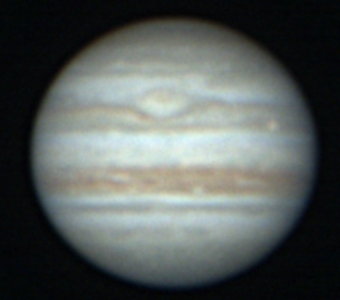
2002/01/25 09:59:58 (UT)
CMI = 108.0, CMII = 84.4, CMIII = 166.8
De = +2.0, E.Dia = 45.92"
8 frames composite
Seeing=4/10,Trans=3/5
25cm+barlow3x(F=34)+prism 2d+Picona(1/7s)
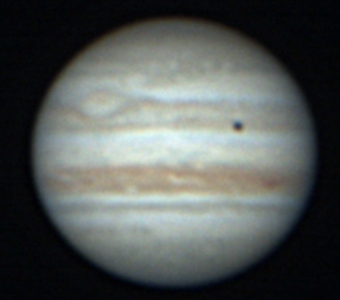
2002/01/25 10:47:23 (UT)
CMI = 136.9, CMII = 113.0, CMIII = 195.5
De = +2.0, E.Dia = 45.92"
6 frames composite
Seeing=4/10,Trans=3/5
25cm+barlow3x(F=34)+prism 2d+Picona(1/7s)

2002/01/25 11:22:35 (UT)
CMI = 158.4, CMII = 134.3, CMIII = 216.8
De = +2.0, E.Dia = 45.91"
9 frames composite
Seeing=4/10,Trans=3/5
25cm+barlow3x(F=34)+Picona(1/7s)
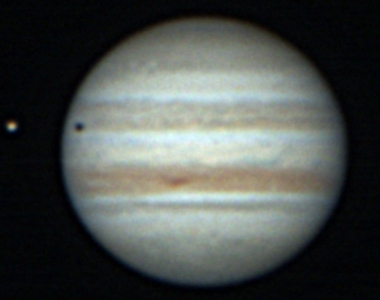
2002/01/25 12:19:44 (UT)
CMI = 193.2, CMII = 168.9, CMIII = 251.3
De = +2.0, E.Dia = 45.91"
8 frames composite
Seeing=4/10,Trans=3/5
25cm+barlow3x(F=34)+Picona(1/7s)
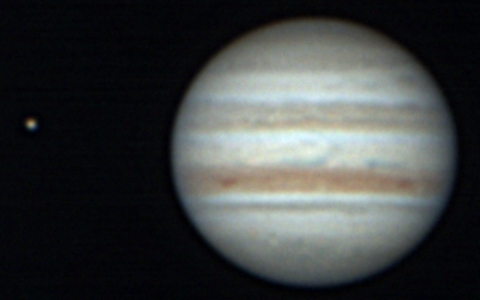
2002/01/25 13:04:53 (UT)
CMI = 220.8, CMII = 196.1, CMIII = 278.6
De = +2.0, E.Dia = 45.91"
11 frames composite
Seeing=4/10,Trans=3/5
25cm+barlow3x(F=34)+Picona(1/7s)

2002/01/25 14:04:26 (UT)
CMI = 257.1, CMII = 232.1, CMIII = 314.6
De = +2.0, E.Dia = 45.90"
7 frames composite
Seeing=4/10,Trans=1/5
25cm+barlow3x(F=34)+Picona(1/7s)
・シ−イングはいまいちでしたが、曇るまで6時間ほど
粘ってみました。木星半周めぐりのつア−でした。
≪兵庫・加西 永長英夫≫
|
Masahito Niikawa (280mm SC, Digital still camera Minolta DiMAGE5)
|
|

Jupiter on Jan.25, 2002
[1]
2002/01/26 00:42:57 (JST)
2002/01/25 15:42:57 (UT)
CMI = 317.1, CMII = 291.7, CMIII = 14.2
20 frames composite
[2]
2002/01/26 01:23:39 (JST)
2002/01/25 16:23:39 (UT)
CMI = 341.9, CMII = 316.3, CMIII = 38.8
18 frames composite
Email:zba03198@bird.zero.ad.jp
Obs.site : Mozuhonmachi Sakai-City Osaka Japan
Telescope : C11 (SC) D=280mm fl=2800mm
Camera:Minolta DiMAGE5 (w/Minolta GT lens f=50.8mm)
Filter: IR Rejection built in the camera
Exposure : 0.3 sec
Effective F No.: 21 (XP24mm relay lens)
Seeing = 5/10
Transparency = 2/6
Image Processing;
Enhanced with unsharp masking method.
≪大阪府 堺市 新川勝仁≫
|
Toshihiko Ikemura (310mm Newton, Digital still camera NEC PICONA)
|
|
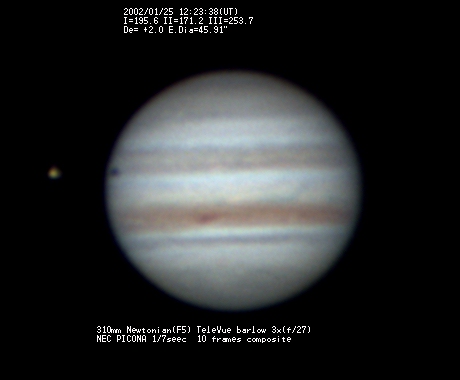
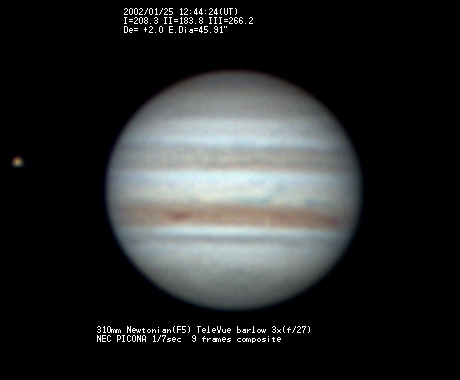

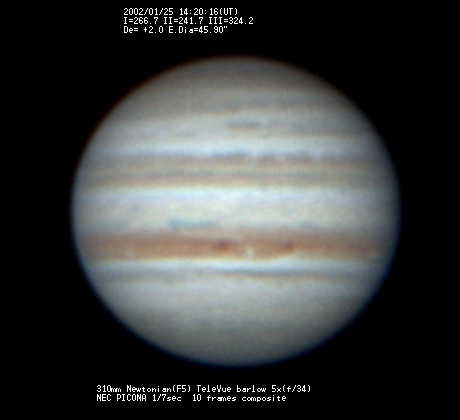

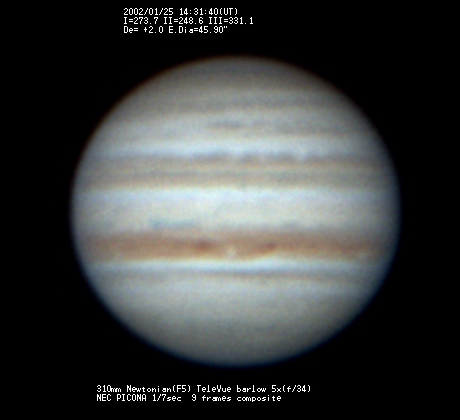
≪愛知県名古屋市 池村俊彦≫
|
Antonio Cidadao (280mm C11+ST-237 CCD camera)
|
|
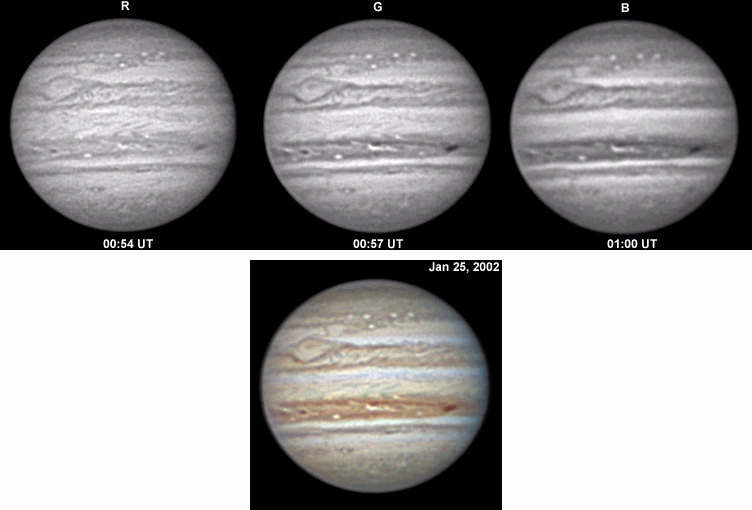

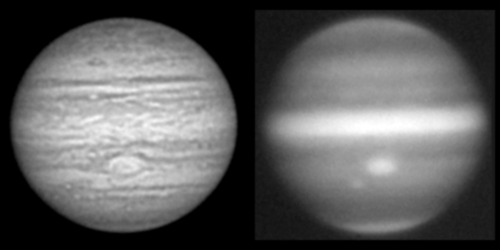
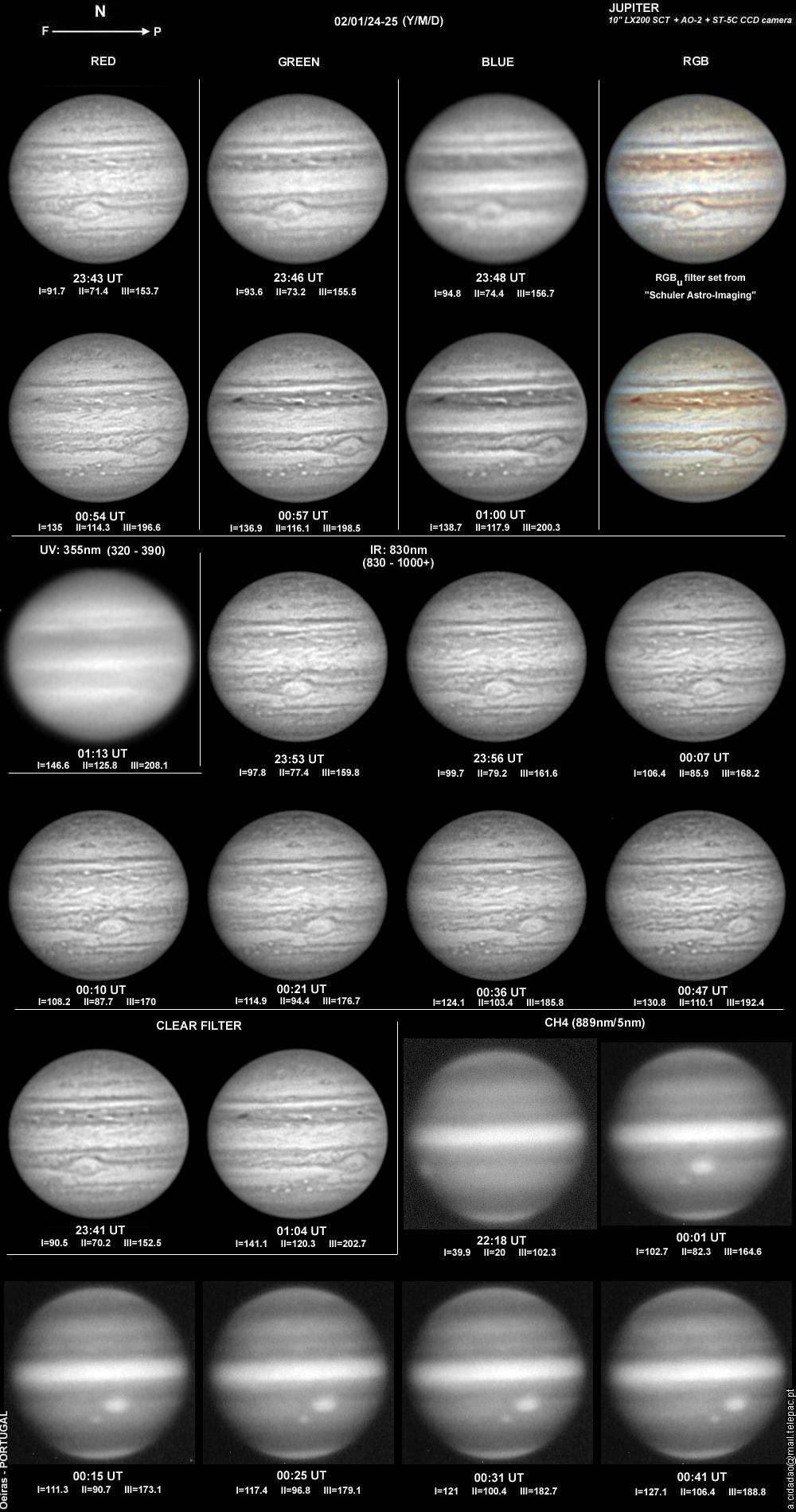
Hello all,
As I'm not sure that tomorrow I will have time to finish processing and
labeling the Jupiter images just obtained, I'm sending some preliminary
data... a RGB set and a "working hypothesis" with methane+ IR that
obviously has to be confirmed, perhaps using planisphere projections. It is
the only RGB set I got, but I have more IR, methane and also clear filter
images.
The methane image is a single 5min integration, IR is the average of
several 15sec integrations and for RGB I averaged several 3.5sec 4,5 sec
and 10sec raws.
Seeing was good for some moments.
Although the SE disturbance is well seen and there is plenty of activity on
the NEB, I will just focus on BA. It does look it has an internal (central)
substructure, at least in IR, R and G filters. In addition, the BA
methane-bright spot is indeed smaller than the IR and visible counterparts.
It also looks round. When superimposing the methane and IR images, obtained
a few minutes apart, the BA methane-bright spot appears to co-localize with
the BA's (central) substructure, thus leaving a methane-negative periphery.
Antonio
(原画像はTIFFで、上が北のものを直しました。)
[GIF ANIME}
I'm still processing Jan 25 images, and until the hole set is ready and
labeled I thought you might want to take a look at this "parallel"
animation obtained using alternatively obtained IR and CH4 images.
Just focusing in the methane images, the animation starts when the STr band
oval disappears in the p limb and ends when the NNTZ red spot appears in
the f limb. The NEB wave pattern is well shown, as is the SE disturbance.
Looking carefully, it is possible to see that the brightness of the
southern part of the EZ methane-bright clouds is non homogeneous at the
disturbance's longitudes. The methane-bright counterpart of BA is always
smaller than the IR image. It is evident how motion helps to identify
faintly positive structudes, namely the SSTC ovals and the tiny spot that
follows BA.
Hi all,
Attached to this and another message you will find my latest jupiter
images, obtained on Jan 25 and 27.
I have already commented Jan25 images, and I will now make a very brief
comparison with those of Jan27.
BA continues to be very distinct on Jan 27, and still shows a cloud just N
of it (unfortunately clouds here on Earth interrupted the session and only
IR data was obtained showing BA; the oval was still near the f limb, but
looked "normal" to me).
The STr band continued to become distinct in its f end, that is near the
GRS, leaving some tiny dark spots in its track. Currently the f end of the
STr band is quite near the STr band oval.
Comparing Jan 25 and 27 images the progression of the SE disturbance and
apparent evolving rift activity in NEB is visible.
Good observations
≪アントニオ シダダオ ポルトガル≫
 ALPO-Japan Latest
ALPO-Japan Latest  Jupiter Section
Jupiter Section






















ALPO-Japan Latest
Jupiter Section